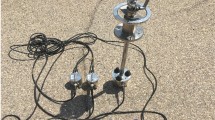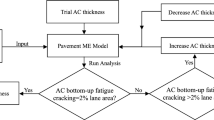Abstract
Cavities under roads are one of the main reasons for early structural damage to pavements. It is necessary to conduct a structural analysis of road sections with cavities and evaluate the possibility of pavement cracking caused by different cavity sizes. In this study, an analysis method for evaluating the possibility of pavement cracking based on the load-mechanical response is proposed. An example library of the mechanical response of asphalt concrete (AC) pavements was established by numerical simulation. Based on the tensile cracking characteristics of pavements in the mechanical response research, the tensile strain at the bottom of the AC layer was selected as the key analysis parameter. Sensitivity analysis of the tensile strain was conducted, and the main factors controlling pavement cracking were determined. A tensile strain response prediction model was established using multiple linear regression, and its reliability was verified. The cavity influence coefficient (CIC) and pavement cracking factor (PCF) were constructed to analyze the cracking possibility. The variation in PCF with the cavity size and pavement structure parameters was studied. A quantitative relationship between the depth and length of the cavity for a given PCF was obtained. This law conforms to a power function. The possibility of pavement cracking can be determined by measuring the cavity size. Compared to the existing cavity management system, the proposed method provided analysis results of the cracking possibility that were more consistent when the cavity depth was small and the length was long. The findings of this study provide new insights for evaluating the possibility of pavement cracking.
Similar content being viewed by others
References
Fernandes F M, Pais J C. Laboratory observation of cracks in road pavements with GPR. Construct Build Mater, 2017, 154: 1130–1138
Huang W, Liang S M, Wei Y. Surface deflection-based reliability analysis of asphalt pavement design. Sci China Tech Sci, 2020, 63: 1824–1836
Norouzi Y, Ghasemi S H, Nowak A S, et al. Performance-based design of asphalt pavements concerning the reliability analysis. Construct Build Mater, 2022, 332: 127393
Zhong Y H, Zhang B, Guo C C, et al. Research on the identification method for void location of semi-rigid base pavement. Appl Mech Mater, 2011, 94–96: 1257–1260
Rasol M, Pais J C, Pérez-Gracia V, et al. GPR monitoring for road transport infrastructure: A systematic review and machine learning insights. Construct Build Mater, 2022, 324: 126686
Xu X, Zeng Q, Li D, et al. GPR detection of several common subsurface voids inside dikes and dams. Eng Geol, 2010, 111: 31–42
Liu H, Shi Z S, Li J H, et al. Detection of road cavities in urban cities by 3D ground-penetrating radar. Geophysics, 2021, 86: WA25–WA33
Lai W W L, Chang R K W, Sham J F C. A blind test of nondestructive underground void detection by ground penetrating radar (GPR). J Appl Geophys, 2018, 149: 10–17
Li T, Zhang Z Z, Zong L D. Study of formation mechanism and prediction of sinkholes in soil stratum induced by subterranean cavity (in Chinese). Rock Soil Mech, 2015, 7: 1995–2002
Bianchi Fasani G, Bozzano F, Cardarelli E, et al. Underground cavity investigation within the city of Rome (Italy): A multi-disciplinary approach combining geological and geophysical data. Eng Geol, 2013, 152: 109–121
Sun L, Chen C, Sun Q Q. Experimental and finite element analyses on the corrosion of underground pipelines. Sci China Tech Sci, 2015, 58: 1015–1020
Mei C, Liu J H, Shi H Y, et al. Exploring impact of street layout on urban flood risk of people and vehicles under extreme rainfall based on numerical experiments. Sci China Tech Sci, 2023
Wang X W, Xu Y S. Investigation on the phenomena and influence factors of urban ground collapse in China. Nat Hazards, 2022, 113: 1–33
Lai W W L, Chang R K W, Sham J F C, et al. Perturbation mapping of water leak in buried water pipes via laboratory validation experiments with high-frequency ground penetrating radar (GPR). Tunnell Undergr Space Tech, 2016, 52: 157–167
Guo X L, Yang K L, Guo Y X. Leak detection in pipelines by exclusively frequency domain method. Sci China Tech Sci, 2012, 55: 743–752
Chen C Y, Xiao M, Jia H, et al. The genesis of urban underground roads diseases and classification of engineer (in Chinese). Bull Surv Mapp, 2013, 5–9
Zhang C P, Zhang D L, Wang M S, et al. Catastrophe mechanism and control technology of ground collapse induced by urban tunneling (in Chinese). Rock Soil Mech, 2010, Supp.1: 303–309
Kong F C, Lu D C, Ma Y D, et al. Novel hybrid method to predict the ground-displacement field caused by shallow tunnel excavation. Sci China Tech Sci, 2023, 66: 101–114
Xiao W X, Qian J S. Analysis of the evolution of subgrade cavity of urban road (in Chinese). Trans Sci Tech, 2016, 02: 125–127
Shi G, Wang Y X, Wu T Y, et al. Model experiments on ground collapse under traffic roads (in Chinese). Chin J Undergr Space Eng, 2020, 16: 1202–1209
Qi G, Wang Z, Chen Y, et al. Analysis of instability mechanism and induced cause of urban pavement in Xining City, China. Adv Mater Sci Eng, 2022, 1–12
Chen A, Zhao Y, Li P, et al. Crack propagation prediction of asphalt pavement after maintenance as a function of initial cracks distribution. Construct Build Mater, 2020, 231: 117157
De Giorgi L, Leucci G. Detection of hazardous cavities below a road using combined geophysical methods. Surv Geophys, 2014, 35: 1003–1021
Ye Z, Zhang C, Ye Y. Principle of a low-frequency transient electromagnetic radar system and its application in the detection of underground pipelines and voids. Tunnell Undergr Space Tech, 2022, 122: 104392
Yang L Q, Han Z J, Guo C C, et al. An innovative solution for the dynamic response of buried pipelines in layered transversely isotropic soil under pavement structures. Comput Geotech, 2022, 143: 104602
Xiang P, Wang H. Optical fibre-based sensors for distributed strain monitoring of asphalt pavements. Int J Pavement Eng, 2018, 19: 842–850
Wang H, Xiang P, Jiang L. Optical fiber sensor based in-field structural performance monitoring of multilayered asphalt pavement. J Lightw Technol, 2018, 36: 3624–3632
Wang H, Xiang P. Strain transfer analysis of optical fiber based sensors embedded in an asphalt pavement structure. Meas Sci Technol, 2016, 27: 075106
Wang M, Li S C, Liu R T, et al. Failure mechanism of void road under vehicle load (in Chinese). Highway, 2022, 7: 63–72
Zhu X Y, Chen W Q, Huang Z Y, et al. Fast multipole boundary element analysis of 2D viscoelastic composites with imperfect interfaces. Sci China Tech Sci, 2010, 53: 2160–2171
Wang W, Su J Y, Ma D H, et al. Integrated risk assessment of complex disaster system based on a non-linear information dynamics model. Sci China Tech Sci, 2012, 55: 3344–3351
Li Z X, Shi X L, Cao J D, et al. CPSO-XGBoost segmented regression model for asphalt pavement deflection basin area prediction. Sci China Tech Sci, 2022, 65: 1470–1481
Tan Y, Long Y Y. Review of cave-in failures of urban roadways in China: A database. J Perform Constr Facil, 2021, 35: 04021080
Kuliczkowska E. Risk of structural failure in concrete sewers due to internal corrosion. Eng Fail Anal, 2016, 66: 110–119
Kuliczkowska E. The interaction between road traffic safety and the condition of sewers laid under roads. Transp Res Part D-Transp Environ, 2016, 48: 203–213
Kuliczkowska E, Parka A. Management of risk of tree and shrub root intrusion into sewers. Urban Forry Urban Greening, 2017, 21: 1–10
JGJ/T 437-2018. Standard for Comprehensive Detection and Risk Evaluation of Underground Disasters in Urban Area. Beijing: Ministry of Housing and Urban-Rural Development of the People’s Republic of China, 2018
Lee K, Park J, Byeong-Hyun C, et al. Analysis of influencing factors on cavity collapse and evaluation of the existing cavity management system. J Korean Geosynth Soc, 2018, 17: 45–54
Zhu X, Zhang Q, Chen L, et al. Mechanical response of hydronic asphalt pavement under temperature—Vehicle coupled load: A finite element simulation and accelerated pavement testing study. Construct Build Mater, 2021, 272: 121884
JTG D50-2017. Specifications for Design of Highway Asphalt Pavement. Beijing: Ministry of Transport of the People’s Republic of China, 2017
Chen X B, Zhao R L, Tong J H, et al. Critical load position for cavities beneath CRCP slab under vehicle loading. J Southeast Univ (English Ed), 2016, 1: 78–84
Mateos A, Millan M A, Harvey J T, et al. Mechanisms of asphalt cracking and concrete-asphalt debonding in concrete overlay on asphalt pavements. Construct Build Mater, 2021, 301: 124086
Cui Y N, Xing Y M, Ni W C. Micromechanical characteristics of the asphalt mixture in bending condition. Sci China Tech Sci, 2013, 56: 392–397
Zhu S Y, Fu Q, Cai C B, et al. Damage evolution and dynamic response of cement asphalt mortar layer of slab track under vehicle dynamic load. Sci China Tech Sci, 2014, 57: 1883–1894
Bańkowski W. Evaluation of fatigue life of asphalt concrete mixtures with reclaimed asphalt pavement. Appl Sci, 2018, 8: 469
Zhou L, Ling J M, Lin X P. Prediction model for fatigue crack of asphalt pavement with environmental factors considered (in Chinese). Chin J High Trans, 2013, 6: 47–52
Zhao J, Wang H. Mechanistic-empirical analysis of asphalt pavement fatigue cracking under vehicular dynamic loads. Construct Build Mater, 2021, 284: 122877
Song Y S, Ding Y L. Fatigue monitoring and analysis of orthotropic steel deck considering traffic volume and ambient temperature. Sci China Tech Sci, 2013, 56: 1758–1766
Author information
Authors and Affiliations
Corresponding author
Additional information
This work was supported by the National Key Research and Development Program of China (Grant Nos. 2020YFB1600504, 2021YFB2600800), and the Major Scientific and Technological Innovation Projects in Shandong Province (Grant No. 2020CXGC011403).
Rights and permissions
About this article
Cite this article
Wang, M., Li, S., Liu, R. et al. Research on pavement cracking possibility based on the load mechanical response. Sci. China Technol. Sci. 66, 3549–3561 (2023). https://doi.org/10.1007/s11431-023-2434-4
Received:
Accepted:
Published:
Issue Date:
DOI: https://doi.org/10.1007/s11431-023-2434-4




